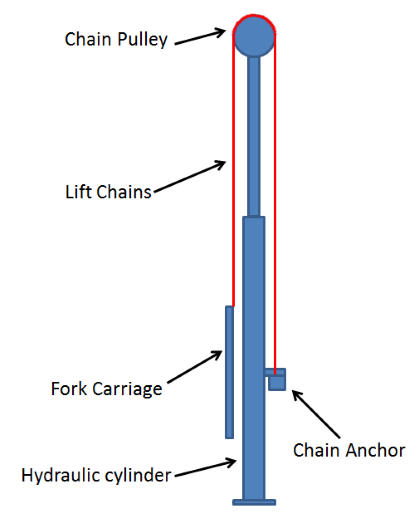Complete Powerpoint slide presentation for forklift instructors. Ready made training course
operation of the forklift mast lift cylinder
 Many people believe that the mast itself carries the load on a forklift truck but this is an urban myth.
Many people believe that the mast itself carries the load on a forklift truck but this is an urban myth.
Pictured left and not to scale is a simplified diagram of the lift cylinder(s) and chains to be found on a forklift truck.
The chain, here shown in red, is anchored at one end, usually to the lift cylinder itself. It then travels up and over the chain pulley at the top and down the front of the mast/cylinder where it is fixed to the fork carriage.
The chain pulley itself is mounted on top of the moving part of the hydraulic cylinder so that when the cylinder extends, the chain pulley rises.
The amount by which the fork carriage and forks lift is exactly double that of the lift cylinder since if, (say), the cylinder moved 1 inch, (2.5 cm), then that amount would be "taken" out of both sides of the chain as it goes over the pulley giving an actual lift of 2 ins or 5 cm.
The main sections of the mast do not carry the actual load being picked up by the forklift truck contrary to popular belief. Quite the reverse is true. The cylinder actually lifts the mast sections in order to provide a path for the fork carriage to run on.
Back in the early 70s when I worked at Yale forklifts we made a model called the KBE. It was quite common for the forklift operator to lift the forks, watch the mast sections rise, lower the forks only for the mast to stay elevated! It used to then fall down spontaneously causing a loud distinctive bang that we all recognised. In the end a block of metal was welded in such a way that when the carriage lowered it struck the mast sections forcing them down also. Marketing department named this device a "pull down tie bar" and sold it as a unique feature:-)
Mast assembly | Fork Carriage and Forks | Mast Critical Dimensions